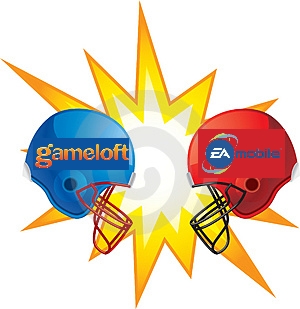 Holy Mother of Football Heaven. Talk about a head-to-head matchup. Gaming heavyweight Electronic Arts against mobile superstar Gameloft. We’ve seen this before, folks, on various mobile devices. But never on a stage like this. And never with the stakes so high. The iPhone is the ultimate arena for this blockbuster duel, and we’re going to judge this match play-by-play for you. We’ll go through each of the major aspects of a quality simulation football game and tell you how each game scored. But first, a little background on the contestants:
Holy Mother of Football Heaven. Talk about a head-to-head matchup. Gaming heavyweight Electronic Arts against mobile superstar Gameloft. We’ve seen this before, folks, on various mobile devices. But never on a stage like this. And never with the stakes so high. The iPhone is the ultimate arena for this blockbuster duel, and we’re going to judge this match play-by-play for you. We’ll go through each of the major aspects of a quality simulation football game and tell you how each game scored. But first, a little background on the contestants:
EA is the owner and developer for the best (and only) football franchise in the world, Madden NFL Football. They’ve also kicked ass on the iPhone platform with titles such as The Sims 3, Need for Speed, Tiger Woods PGA Tour, and more. Gameloft, despite having far less success with their football franchise, has managed to dominate the iPhone platform. Gameloft has racked up more than 6 million sales with titles such as Gangstar, Rise of Lost Empires, Assassin’s Creed: Altair’s Chronicles, and others. This will be a truly epic battle, but nobody can deny that EA, what with more than a decade of experience with the Madden franchise, is favored in the bout of a lifetime: EA’s Madden NFL 2010 head-to-head with Gameloft’s NFL 2010.
Skip to the bottom for a Game Summary as I do not want to spoil it.
The Play-by-Play
Rules: The judge will compare the two on a series of defined characteristics, and can receive either 2 (Safety), 3 (Field Goal), or 6 points (Touchdown) for performance on said characteristics. I, Gagan Biyani, the sole adjudicator in this contest, will also award extra points as I see fit. Simple enough, I hope.
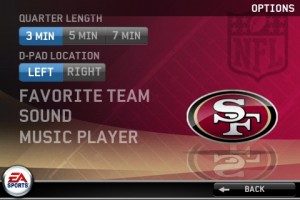 Controls
Controls
Note: This is solely about the location, usability and look/feel of the controls; NOT about how they function with the gameplay (that’s next). The controls in both games are damn near identical. You’ve got an on-screen joystick on the left side of the screen (EA allows you to switch it to the right if you’re a lefty) and a slew of buttons on the right. The buttons change depending on whether you’re offense or defense. We experienced sluggishness on both games, which went away if you restarted your iPhone before firing the app up. EA’s got more button options to control your player, but Gameloft’s controls have a better look and feel. The out-of-game menus are also a wash: Gameloft’s function better (as in, when you tap them you always get where you need to go), while EA’s interface is hella slick but I erred and pressed the wrong button once or twice.
The main differentiator in terms of controls was selecting players, whether on defense or offense. In these games, if you want to throw the ball to a receiver, you tap on the receiver. If you want to change players on defense, you tap on the player you want to switch into. There was an obvious problem with this on offense (which may or may not be unavoidable given the iPhone’s screen size): if you clump players together then it was damn-near impossible to tap the right receiver. God, how many times did I accidentally tap Arnaz Battle instead of the sellout Michael Crabtree in both games. Defense was a different story, primarily because you don’t have too much clumping of players until milliseconds before they converge on the ball carrier. As such, I rarely had an issue selecting defensive players in Gameloft’s NFL 2010. EA was less perfect, and I occasionally tapped the wrong player and furiously had to tap the screen to switch to the right one.
Gameloft scores a touchdown while EA gets a field goal. No extra point for Gameloft, though, because of the receiver issues.
-
Gameloft 6 – EA 3
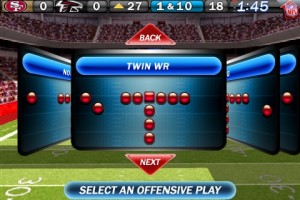 Playcalling
Playcalling
In most sports games, I couldn’t give two shits about playcalling. Basketball and soccer games are just fine without it. Football is a different story. Any Madden player knows that having the right playbook and picking the right plays can be as important as quick reflexes in football simulation games. A common theme becomes clear in this section: Gameloft makes better iPhone games while EA has better football expertise. Accordingly, EA’s playbook was fuller, had more options and allowed you to flip plays (where you take a play that’s going right and flip it so it is the exact same play going left). Gameloft, on the other hand, kicked EA’s behind with its easy-to-use interface and easy-to-read playbook. EA’s plays were pixellated and the playbook was sluggish. This being an iPhone game (read: not for hardcore football gamers), I have to again give the edge to the ease of use over full playbook. EA gets a field goal while Gameloft a touchdown. Again, though, Gameloft misses the extra point because being able to flip plays is essential in my book.
-
Gameloft 12 – EA 6
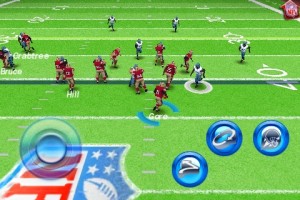 Gameplay – Offense
Gameplay – Offense
Ohhh, Offense. Don’t you just get all warm and fuzzy inside when its your turn with the pigskin? I sure as hell do. Offense is all about style, and I’m a smashmouth kind of guy. None of that pussy shotgun shit. Just like my lord and savior Mike Singletary, I enjoy pounding the rock. Hard. Because of that, I quickly became fond of playing offense on EA’s running platform over Gameloft’s. Both developers were presented with an obvious problem when it came to running the football: with such a small screen size, it’s difficult to time your moves (such as jukes and spins) appropriately. They came up with entirely different solutions, and EA’s is light-years ahead of Gameloft’s. Gameloft decided that they would stop the game (yes, freeze frame in a live-action football game) just as you are about to get hit by a defender, and you would get three choices: spin, power move, or juke. Depending on the choice you picked and the direction of your joystick, you’d either break free or land your ass on the ground. This was far from ideal, for two reasons. First, well, it breaks up an otherwise fluid game. Second, you can only do that so many times, and so Gameloft basically dooms your runner by allowing you to do moves only once per play. To make matters worse, Gameloft didn’t have any boost/turbo button, which in my humble opinion, really makes running fun. So what did EA do? EA nailed it. They allow you to choose when you want to slow the play down (not freeze it, but Max Payne-style slow motion), and then give you a short window of time during which you can spin, juke left/right, or power move. It works like a charm, and I (as the almighty Frank Gore) pwned the opposing defenses. Oh, and they didn’t forget to give you a boost button to speed up at the right time.
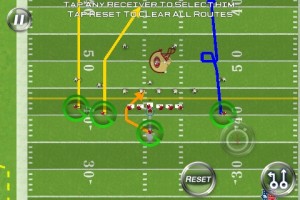 If the rushing game was utter domination by EA, then the passing game was more of a quiet victory. Neither of them had spectacular passing gameplay. For one thing, it was hard to choose receivers (as previously mentioned). More importantly, it was hard to decide which receivers to throw to. Unlike traditional football games where you can see the entire field easily and you feel like a QB going back to pass, the iPhone screen prohibits the same kind of QB-esque vision. Instead, both games employed a red-yellow-green system to tell you which player was fit to pass to. As the receivers ran their routes, a button appeared above them and changed color depending on their availability for a throw. This worked as well as it could on a 3-inch screen, but still wasn’t ideal. But it was the little things that put EA ahead. For example, you can draw on hot routes before the play, directly on the screen. Brilliant! It works perfectly and I basically always drew some pattern on-screen before a player went out for a pass. Touchdown + 2-point conversion for EA; no points for Gameloft.
If the rushing game was utter domination by EA, then the passing game was more of a quiet victory. Neither of them had spectacular passing gameplay. For one thing, it was hard to choose receivers (as previously mentioned). More importantly, it was hard to decide which receivers to throw to. Unlike traditional football games where you can see the entire field easily and you feel like a QB going back to pass, the iPhone screen prohibits the same kind of QB-esque vision. Instead, both games employed a red-yellow-green system to tell you which player was fit to pass to. As the receivers ran their routes, a button appeared above them and changed color depending on their availability for a throw. This worked as well as it could on a 3-inch screen, but still wasn’t ideal. But it was the little things that put EA ahead. For example, you can draw on hot routes before the play, directly on the screen. Brilliant! It works perfectly and I basically always drew some pattern on-screen before a player went out for a pass. Touchdown + 2-point conversion for EA; no points for Gameloft.
-
EA 14 – Gameloft 12
… and we’ve got ourselves a ball game, folks!
Gameplay – Defense
For video game developers, Defense is tough to get right. And it showed. While offense was tolerable for both developers, defense was far less smooth. As usual, both employ the same general system: there’s a switch players button or you can tap on the player you want to control. Use the joystick to move and if you run into the guy with the rock you take him down. That said, there’s a lot to defense that they didn’t get right. For example, actually executing on a blitz or a tackle on EA’s Madden was impossible. I consider myself to be a fairly solid blitzer (I suck at coverage), and dial up blitzes like Jim Johnson with the Eagles (>60%). For the life of me, I couldn’t get within 2 feet of the quarterback in Madden. Gameloft’s was much more realistic: I had a 20% sack success rate, which is much more in line with what I would expect.
EA’s coverage also faltered. It didn’t auto-switch you into the defensive back when the ball was in the air and you just plainly didn’t have enough time to do it yourself. Of course, a lot of times you want the computer to handle it, but it would be nice to have the option. Gameloft’s coverage was far better. Once the QB let’s the ball go, two buttons pop up for just a second or two. If you tap it, you have a chance at batting the pass down or intercepting the ball – otherwise, the computer does its thang. That isn’t to say Gameloft didn’t have its issues. Once in awhile a defensive back would completely blow its coverage or a middle linebacker would whiff a non-mobile QB without explanation. Pros don’t do that, and it seemed like an unintentional flaw in the defensive AI (more on that later). Ultimately, though, Gameloft outgunned EA on defense. Touchdown Gameloft, extra point good. Nada for EA.
-
Gameloft 19 – EA 14
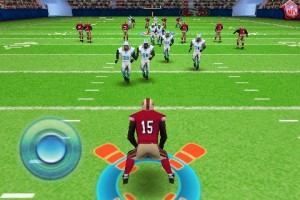 Gameplay – Special Teams
Gameplay – Special Teams
I love me some kick returns. Maybe its cuz I loved going batshit crazy in the stands when DeSean Jackson of Cal would take one to the house. Or maybe it’s just because it’s an important and often overlooked part of football. Well, Gameloft didn’t even attempt at creating a solid return game. Rare was the punt or kick that was returnable. And when it was, the defense just swarmed you without any chance of evasion. Now, of course, it is important for there to be some realism, and trust me, I understand that. But EA was far more realistic: some kickoffs went in the end zone and some punts went out of bounds. Every once in awhile, though, you were off to the races and had a shot at 6. It was exhilarating and a real treat to try to return a punt or kick in Madden for the iPhone.
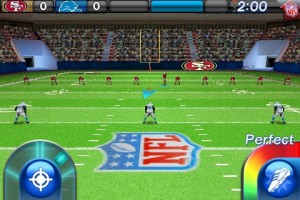
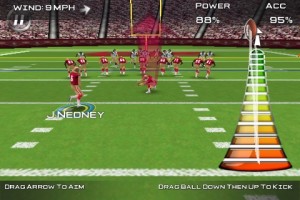 Kicking/Punting, the other half of special teams, was solid on both games, with EA edging Gameloft just a tad. Gameloft employed the standard accuracy/power system. There are two dials, one for accuracy and one for power. The dial turns clockwise then counter-clockwise then back again, and you’re goal is to catch it in the middle. It worked well and was sufficiently challenging. EA, on the other hand, brought something fresh and new to the table. Look at the screenshot to see what it looks like. Basically, you draw a line down the kicking icon and then back up. The faster you do it, the more power you get. Accuracy is determined by how close your lines are two each other. Innovation at work, and EA takes the cake on both counts of Special Teams. Touchdown and a 2-point conversion for EA; a field goal for Gameloft.
Kicking/Punting, the other half of special teams, was solid on both games, with EA edging Gameloft just a tad. Gameloft employed the standard accuracy/power system. There are two dials, one for accuracy and one for power. The dial turns clockwise then counter-clockwise then back again, and you’re goal is to catch it in the middle. It worked well and was sufficiently challenging. EA, on the other hand, brought something fresh and new to the table. Look at the screenshot to see what it looks like. Basically, you draw a line down the kicking icon and then back up. The faster you do it, the more power you get. Accuracy is determined by how close your lines are two each other. Innovation at work, and EA takes the cake on both counts of Special Teams. Touchdown and a 2-point conversion for EA; a field goal for Gameloft.
-
Gameloft 22 – EA 22
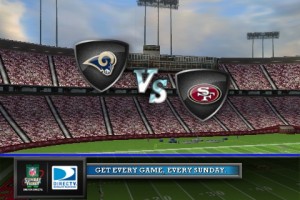 Graphics
Graphics
Uhh, you’ve got enough pictures of the games to figure this out (I think). My vote is hands-down Gameloft. Not only are the menu screens, playbook and the intro video (EA has none) almost as eye-catching as cheerleaders on astroturf, but the in-game graphics are far superior to EA’s. A bit pixelated and worn, EA’s in-game graphics are just average for an $8 game. Though EA did a great job with the menu screens, I’m going to ding them here for having ads for DirecTV littered throughout the game. I’m all for ads in games and really hate those who hate advertising. That said, Gameloft doesn’t have ads and EA does. Advantage Gameloft.
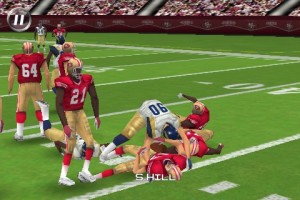 But it didn’t stop at pretty graphics for Gameloft. They’ve got replays, a feature lacking for EA, so you can replay massive hits or extraordinary catches. Hell, if you manage to pull off something like Terrell Owens’ Catch II or Franco Harris’ Immaculate Reception, you’re gonna want to watch it again. And again. And again. EA also faltered on delivering real-life representations of on-field actions. Basically, if I watch a tackle on Gameloft’s NFL 2010, it looks like a tackle. EA’s looks like two guys playing Twister on grass. The tacklers hands go right through the chest of the tackled player. Gameloft wasn’t perfect on this either – catches didn’t always look realistic, but EA was by far the worst offender on this front. Gameloft gets a touchdown with an extra point; EA gets a field goal.
But it didn’t stop at pretty graphics for Gameloft. They’ve got replays, a feature lacking for EA, so you can replay massive hits or extraordinary catches. Hell, if you manage to pull off something like Terrell Owens’ Catch II or Franco Harris’ Immaculate Reception, you’re gonna want to watch it again. And again. And again. EA also faltered on delivering real-life representations of on-field actions. Basically, if I watch a tackle on Gameloft’s NFL 2010, it looks like a tackle. EA’s looks like two guys playing Twister on grass. The tacklers hands go right through the chest of the tackled player. Gameloft wasn’t perfect on this either – catches didn’t always look realistic, but EA was by far the worst offender on this front. Gameloft gets a touchdown with an extra point; EA gets a field goal.
-
Gameloft 29 – EA 25
Artificial Intelligence
Like I said before, EA knows football; Gameloft knows video games. The story holds true during the AI debate as well. EA did a great job with AI. When my corner blitzed, bam! Kurt Warner made me pay with a 10-yard pass. In Gameloft’s NFL 2010, if I blitzed from an unexpected location, nobody picked it up and the QB hit the dirt. Similar stuff occurred when you compare the defensive backs. EA’s covered the receivers like a charm, but Gameloft’s were a bit more haphazard. Similar stuff with offense. While EA’s blockers moved naturally with the ball carrier, Gameloft’s stumbled and fumbled their way over, often missing their assignments and letting the defense smother the RB. Of course, Gameloft’s AI was still above par. The players generally did what they should and that was true for EA as well. The mistakes just occurred more often on Gameloft’s side than EA, and that’s why I’ve got to give EA a touchdown (extra point) and Gameloft a field goal.
-
Gameloft 32 – EA 32
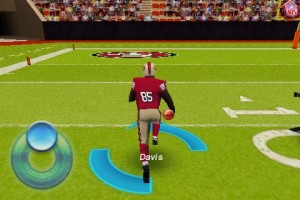 Overtime
Overtime
This won’t be a traditional sudden death over time. That just wouldn’t be right. Instead, I’ll simply list off cool feature or two that one of the apps has that the other doesn’t and award points accordingly.
In EA’s Career Mode (which is really just a Season mode), you can trade, add and drop players. There are also more options for stats and such. Problem is you can trade anyone for anyone, so it’s easy to cheat. I traded Carson Palmer (don’t ask why I chose him over Tom Brady or Peyton Manning: it was a random test) for a 3rd string Offensive Lineman. It was a joke. So while I’d traditionally give EA 2 points for this, I can only justify 1.
-
EA 33 – Gameloft 32
Gameloft’s got a playoff mode that allows you to skip the regular season and go straight into the post-season. Pretty sweet if you’ve got less time on your hands but still want to hoist the virtual Lombardi Trophy. +1.
-
EA 33 – Gameloft 33
Summary
It’s a freakin’ toss up. I know that’s lame. Don’t hate me for it. I really did go back and forth while I was playing Madden to compare how it stacked up to NFL 2010. I just can’t decide. Honestly, I’m happy they’re both $8 because at that price, it’s a steal even if you get both. If you love running, go EA. If you love blitzing, go Gameloft. It’s a classic what-do-you-want situation. Want your game to be smooth and easy-to-use? Buy Gameloft. Prefer a solid AI where players do what they should? Buy EA.
Bottom line: Either of these games will satisfy your football itch and you’ll find yourself continuing to ask the question: what can’t this little device do?